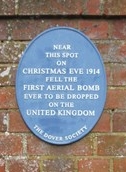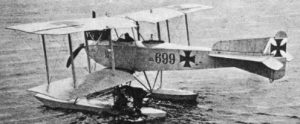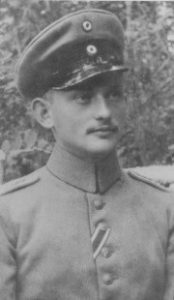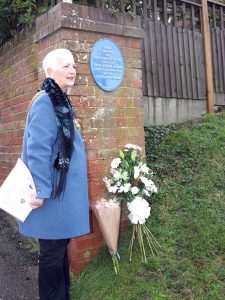
This was the first of the original 10 Dover Society Millennium Plaques and was unveiled in Mid-February 2000. It is situated on the wall of 1 Taswell Close at the junction with Taswell Street.
Peter Johnson with the help of George Youden and the use of a Dover Express 1914-18 bomb and shell map managed to pinpoint the impact spot as in a garden at the rear of St James’s Rectory what is now 1 Taswell Close.
In 1914 the Germans had offered a prize for the first German airman to bomb Dover or Britain. The first attempt, on 21st December, saw both bombs land in the sea near the Admiralty Pier.

A Friedrichshafen FF29 Floatplane
Then just before 11am on Christmas Eve 1914 a German Friedrichshafen FF29 aeroplane of the See Flieger Abteilung 1 (Seaplane Unit No.1 or SFA 1) flew over Dover unarmed except for a bomb carried by Lieutenant Alfred von Prondzynski, between his knees. Although not the pilot he claimed the prize and made history as the first person to drop a bomb from a plane on Britain. At the time the only way to drop a bomb was to lift it by hand, hold it over the side of the plane and let go when the bomber thought he could hit the target.
Lieutenant Alfred von Prondzynski, was a strong supporter of the Kaiser, spoke good English and enjoyed pre-war holidays in Brighton. On the last day of the war he was seriously wounded. He underwent several operations but the metal alloy used replace his shattered bones later poisoned his blood causing his death in 1932.

Lt Prondzynski
The bomb made a large crater but only caused one casualty, Mr James Banks, a gardener, slightly injured when knocked out of a tree he was pruning. Minimal damage was caused with just a few broken windows. After the bombing two British aeroplanes, armed, it is said, with pistols and a seaplane took off in pursuit but failed sight their quarry as it had vanished in clouds as it flew back to its’ Belgium airbase of Zeebrugge.
Fragments of this bomb were mounted on a shield and presented to the King. Another fragment was bought by a Bootle man at auction for £20, the money was donated to the Red Cross.

Town Mayor Mrs Pam Brivio Christmas Eve 2014
On Christmas Eve 2014 a short memorial service marking the centenary, led by the Right Worshipful the Town Mayor, Councillor Mrs Pam Brivio, was held in Taswell Street adjacent to the blue plaque.
In World War 1 aerial warfare was very much a psychological weapon rather than a practical one but the war encouraged the use of the aeroplane in conflict and while not playing a fundamental role in the war it was very much the beginning of a new element in warfare. By the end of the war 184 bombs had fallen on the town from enemy aircraft as well as 23 shells from enemy ships. 113 air-raids, in which 23 people including 3 children were killed and 71 people including 12 children were injured, were recorded within the Borough of Dover.
Alan Lee

